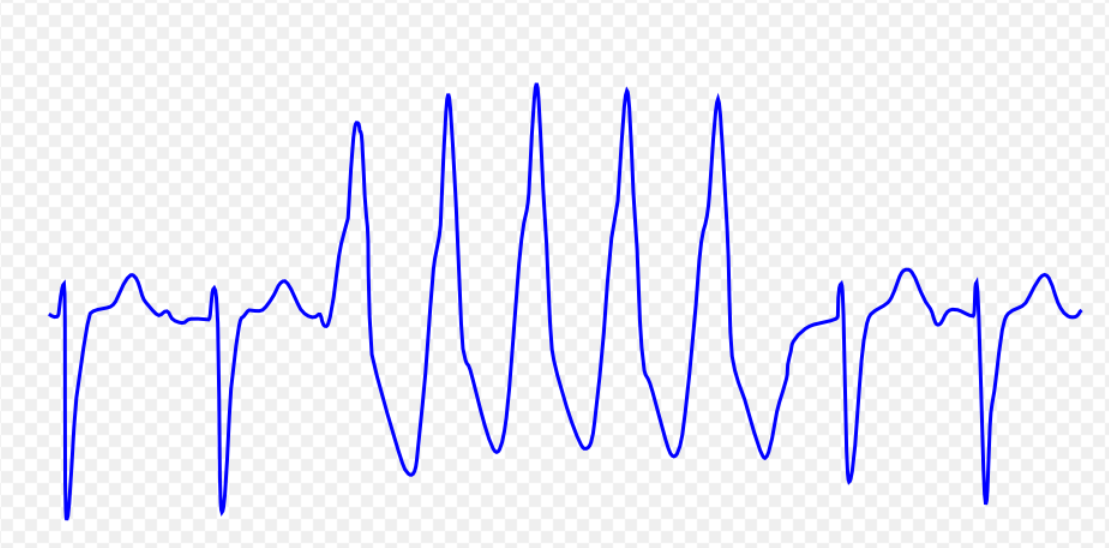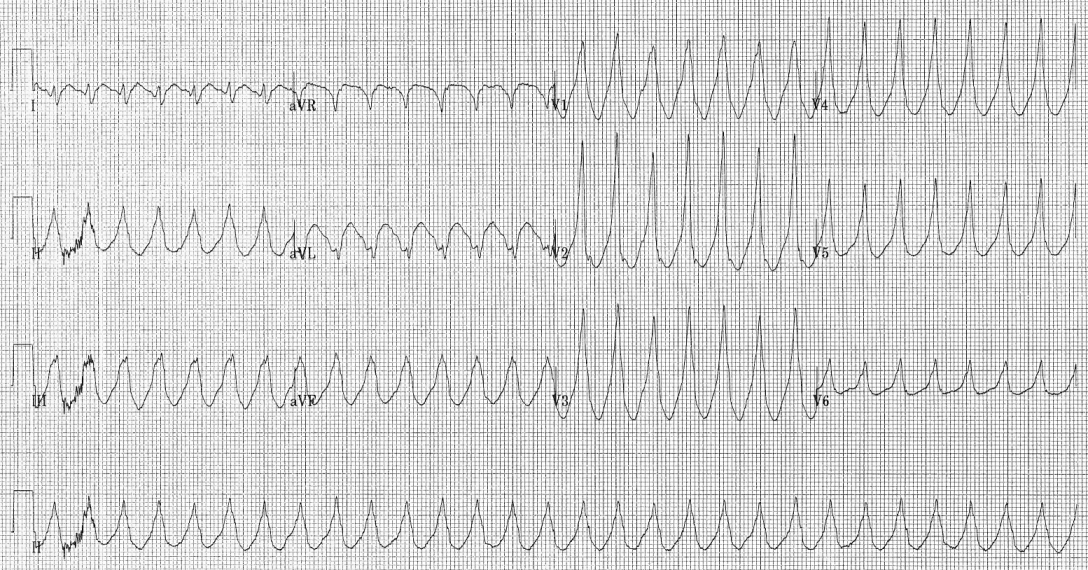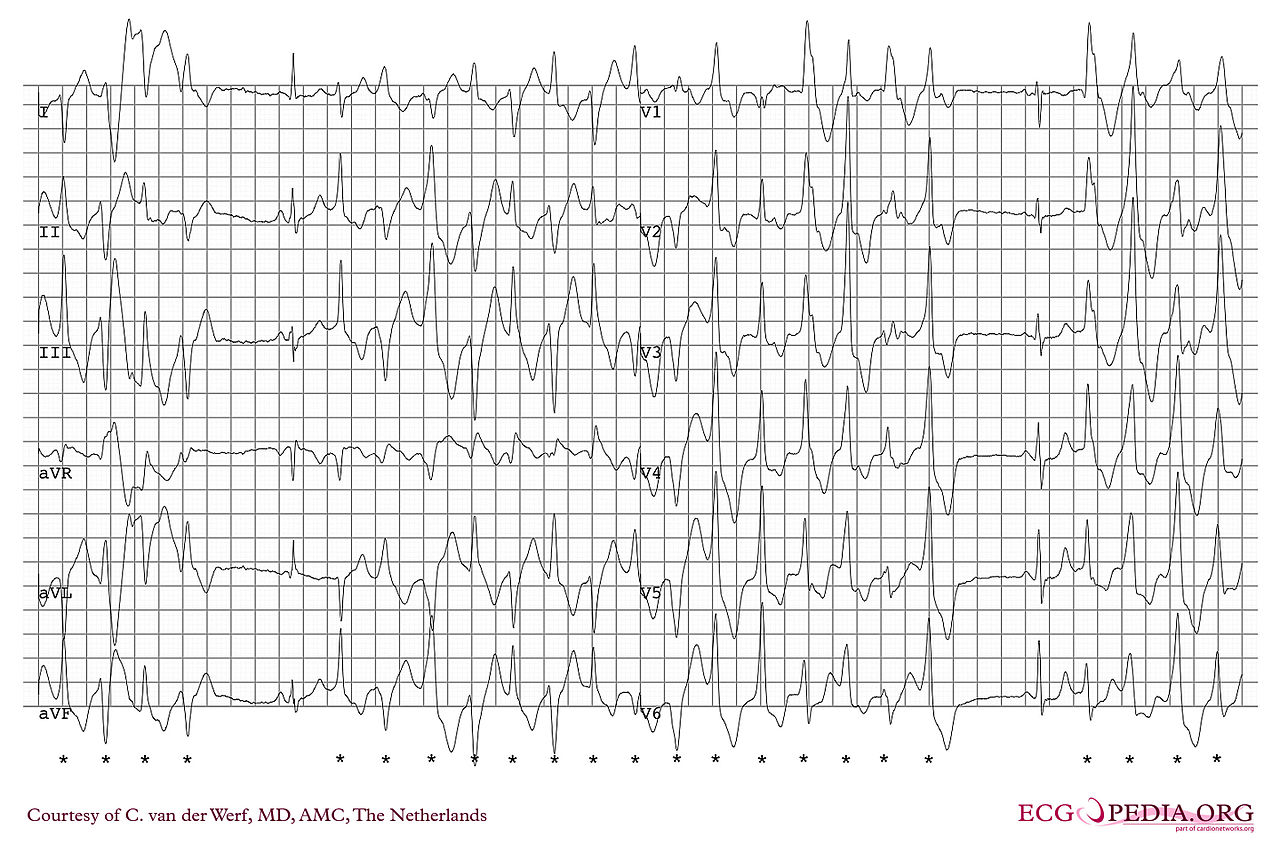|
|
| (37 intermediate revisions by 5 users not shown) |
| Line 1: |
Line 1: |
| __NOTOC__ | | __NOTOC__ |
| {{Ventricular tachycardia}} | | {{Ventricular tachycardia}} |
| {{CMG}}; '''Associate Editor-In-Chief:''' {{CZ}} | | {{CMG}}; '''Associate Editor-In-Chief:''' {{Sara.Zand}} {{CZ}} |
|
| |
|
| ==Overview== | | ==Overview== |
| Ventricular tachycardia refers to a rhythm with a heart rate in excess of 100 (and in some definitions 120) beats per minute that arises distal to the [[bundle of His]]. Ventricular tachycardia can be classified under three main categories. Firstly, The morphology of the [[QRS complexes]] on the EKG ([[monomorphic ventricular tachycardia]] vs [[polymorphic ventricular tachycardia]]). Secondly, The duration of the episode. Thirdly, The symptoms associated with the episode. | | [[Ventricular tachycardia]] refers to a [[rhythm]] with a [[heart rate]] in excess of 100 (and in some definitions 120) [[beats per minute]] that arises distal to the [[bundle of His]]. [[Ventricular tachycardia]] can be classified based on morphology and duration of [[tachyarrhythmia]]. The [[morphology]] of the [[QRS complexes]] on the [[ECG]] maybe ([[monomorphic ventricular tachycardia]]or [[polymorphic ventricular tachycardia]]). In sustained [[VT]] duration of [[VT]] lasts > 30 sec or [[VT]]< 30 sec that needs to termination due to compromised [[hemodynamic]]. Nonsustained, or unsustained [[VT]] is more than 3 consecutive [[premature ventricular complexes]] with spontaneously termination. [[Bidirectional VT]] is a type of [[VT]] with beat to beat changing [[QRS]] frontal plane [[axis]] indicating of [[digoxin toxicity]] or [[catecholaminergic polymorphic VT]].[[Torsades de pointed]] is a type of [[polymorphic VT]] in the setting of [[long QT]] interval which is characterized by [[twisting of the points]], waxing and waning [[QRS]] amplitude, Long-short sequence with long-coupling interval to the first [[VT]] beat, maybe initiated after [[bradycardia]] such as [[high grade AV block]].[[Ventricular flutter]] |
| | is explained as a regular [[ventricular arrhythmia]] with rate about 300 [[beat per minute]] (bpm), or cycle length 200 ms, [[sinusoidal]] [[monophorphic]] [[QRS]] complexes, [[Without]] any isoelecterical interval between successive [[QRS]] complexes. [[Ventricular fibrillation]] is a [[rapid]], grossly irregular [[electrical]] activity with variation in morphologic waveforms by [[ventricular]] rate >300bpm, [[cycle length]] <200 ms. [[VT]]/ [[VF]] storm is an electerical storm or [[cardiac]] instability due to ≥ 3 episodes of sustained [[VT]], [[VF]] or shock delivery from [[ICD]] within 24 hours. |
|
| |
|
| ==Classification Based Upon Morphology of the QRS Complexes== | | ==Classification Based Upon Morphology of the QRS Complexes== |
| ===Monomorphic ventricular tachycardia===
| |
| Monomorphic ventricular tachycardia is defined as a [[QRS complex]] morphology that is identical from beat-to-beat in all leads of the surface [[electrocardiogram]] (EKG).
| |
| ====EKG Example====
| |
| Shown below is an image of electrocardiogram depicting monomorphic ventricular tachycardia.
| |
| [[Image:Electrocardiogram of Ventricular Tachycardia.png|center|500px|12 lead [[electrocardiogram]] showing a run of monomorphic ventricular tachycardia (VT)]]
| |
|
| |
|
| ===Polymorphic ventricular tachycardia=== | | ==== Classification of [[ventriculat arrhythmia]]: ==== |
| [[Polymorphic ventricular tachycardia]], is defined as [[QRS complexes]] with beat-to-beat variability in morphology. This most commonly appears as a cyclical progressive change in cardiac axis referred to by its french eponym [[Torsade de pointes]] (literally translating to "twisting of the points").
| | {| class="wikitable" |
| | | ! align="center" style="background:#4479BA; color: #FFFFFF;" + |Term |
| ==Classification Based Upon Duration of Episode== | | ! align="center" style="background:#4479BA; color: #FFFFFF;" + |Definition |
| === Non-sustained Ventricular Tachycardia or Paroxysmal Ventricular Tachycardia ===
| | ! align="center" style="background:#4479BA; color: #FFFFFF;" + |Feature |
| * Rapid succession of three or more ectopic beats.
| | ! |
| * Self terminates within 30 seconds.
| |
| | |
| ===Sustained Ventricular Tachycardia===
| |
| * Lasts more than 30 seconds.
| |
| | |
| ===Incessant Ventricular Tachycardia===
| |
| * The ventricular tachycardia is recurrent and the episodes are interrupted by only a few sinus beats.
| |
| | |
| ==Classification Based Upon Symptoms==
| |
| A third way to classify [[ventricular tachycardia]] is on the basis of its symptoms:
| |
| ===Pulseless VT===
| |
| Pulseless VT is associated with no effective [[cardiac output]], hence, no effective [[pulse]], and is a cause of [[cardiac arrest]]. In this circumstance it is best treated the same way as [[ventricular fibrillation]] ([[VF]]) and is recognized as one of the shockable rhythms on the [[cardiac arrest]] protocol.
| |
| | |
| ===Perfusing Rhythm with VT===
| |
| Some [[VT]] is associated with reasonable cardiac output and may even be asymptomatic. The heart usually tolerates this rhythm poorly in the medium to long term, and patients may certainly deteriorate to [[pulseless VT]] or to [[VF]].
| |
| ==2006 ACC/AHA/ESC Guidelines for Management of Patients With Ventricular Arrhythmias and the Prevention of Sudden Cardiac Death - Sustained Monomorphic Ventricular Tachycardia (DO NOT EDIT) <ref name="pmid16935995">{{cite journal| author=Zipes DP, Camm AJ, Borggrefe M, Buxton AE, Chaitman B, Fromer M et al.| title=ACC/AHA/ESC 2006 Guidelines for Management of Patients With Ventricular Arrhythmias and the Prevention of Sudden Cardiac Death: a report of the American College of Cardiology/American Heart Association Task Force and the European Society of Cardiology Committee for Practice Guidelines (writing committee to develop Guidelines for Management of Patients With Ventricular Arrhythmias and the Prevention of Sudden Cardiac Death): developed in collaboration with the European Heart Rhythm Association and the Heart Rhythm Society. | journal=Circulation | year= 2006 | volume= 114 | issue= 10 | pages= e385-484 | pmid=16935995 | doi=10.1161/CIRCULATIONAHA.106.178233 | pmc= | url=http://www.ncbi.nlm.nih.gov/entrez/eutils/elink.fcgi?dbfrom=pubmed&tool=sumsearch.org/cite&retmode=ref&cmd=prlinks&id=16935995}}</ref>==
| |
| | |
| {|class="wikitable" | |
| |-
| |
| | colspan="1" style="text-align:center; background:LightGreen"|[[ACC AHA Guidelines Classification Scheme#Classification of Recommendations|Class I]]
| |
| |-
| |
| | bgcolor="LightGreen"|<nowiki>"</nowiki>'''1.''' Wide-QRS tachycardia should be presumed to be VT if the diagnosis is unclear. ''([[ACC AHA Guidelines Classification Scheme#Level of Evidence|Level of Evidence: C]])'' <nowiki>"</nowiki>
| |
| |-
| |
| | bgcolor="LightGreen"|<nowiki>"</nowiki>'''2.''' Direct-current [[cardioversion]] with appropriate [[sedation]] is recommended at any point in the treatment cascade in patients with suspected sustained monomorphic VT with [[hemodynamic compromise]]. ''([[ACC AHA Guidelines Classification Scheme#Level of Evidence|Level of Evidence: C]])'' <nowiki>"</nowiki>
| |
| |} | |
| | |
| {|class="wikitable"
| |
| |-
| |
| |colspan="1" style="text-align:center; background:LightCoral"|[[ACC AHA guidelines classification scheme#Classification of Recommendations|Class III]] (Harm)
| |
| |-
| |
| |bgcolor="LightCoral"|<nowiki>"</nowiki>'''1.''' [[Calcium channel blockers]] such as [[verapamil]] and [[diltiazem]] should not be used in patients to terminate wide-QRS-complex tachycardia of unknown origin, especially in patients with a history of myocardial dysfunction. ''([[ACC AHA guidelines classification scheme#Level of Evidence|Level of Evidence: C]])'' <nowiki>"</nowiki>
| |
| |}
| |
| | |
| {|class="wikitable"
| |
| |-
| |
| | colspan="1" style="text-align:center; background:LemonChiffon"|[[ACC AHA Guidelines Classification Scheme#Classification of Recommendations|Class IIa]]
| |
| |-
| |
| |bgcolor="LemonChiffon"|<nowiki>"</nowiki>'''1.''' Intravenous [[procainamide]] (or ajmaline in some European countries) is reasonable for initial treatment of patients with stable sustained monomorphic VT. ''([[ACC AHA Guidelines Classification Scheme#Level of Evidence|Level of Evidence: B]])''<nowiki>"</nowiki>
| |
| |-
| |
| |bgcolor="LemonChiffon"|<nowiki>"</nowiki>'''2.''' Intravenous [[amiodarone]] is reasonable for patients with sustained monomorphic VT that is [[hemodynamically unstable]], refractory to conversion with countershock, or recurrent despite [[procainamide]] or other agents. ''([[ACC AHA Guidelines Classification Scheme#Level of Evidence|Level of Evidence: C]])''<nowiki>"</nowiki>
| |
| |-
| |
| |bgcolor="LemonChiffon"|<nowiki>"</nowiki>'''3.''' Transvenous catheter pace termination can be useful to treat patients with sustained monomorphic VT that is refractory to [[cardioversion]] or is frequently recurrent despite [[antiarrhythmic]] medication. ''([[ACC AHA Guidelines Classification Scheme#Level of Evidence|Level of Evidence: C]])''<nowiki>"</nowiki>
| |
| |} | |
| | |
| {|class="wikitable"
| |
| |-
| |
| | colspan="1" style="text-align:center; background:LemonChiffon"|[[ACC AHA Guidelines Classification Scheme#Classification of Recommendations|Class IIb]]
| |
| |- | | |- |
| |bgcolor="LemonChiffon"|<nowiki>"</nowiki>'''1.''' Intravenous [[lidocaine]] might be reasonable for initial treatment of patients with stable sustained monomorphic VT specifically associated with acute [[myocardial ischemia]] or [[acute myocardial infarction|infarction]]. ''([[ACC AHA Guidelines Classification Scheme#Level of Evidence|Level of Evidence: C]])''<nowiki>"</nowiki> | | | rowspan="6" |[[Ventricular tachycardia]]<ref>{{cite journal|title=ACC/AHA/HRS 2006 Key Data Elements and Definitions for Electrophysiological Studies and Procedures|journal=Circulation|volume=114|issue=23|year=2006|pages=2534–2570|issn=0009-7322|doi=10.1161/CIRCULATIONAHA.106.180199}}</ref> |
| |}
| |
| | |
| ==2006 ACC/AHA/ESC Guidelines for Management of Patients With Ventricular Arrhythmias and the Prevention of Sudden Cardiac Death - Polymorphic Ventricular Tachycardia (DO NOT EDIT) <ref name="pmid16935995">{{cite journal| author=Zipes DP, Camm AJ, Borggrefe M, Buxton AE, Chaitman B, Fromer M et al.| title=ACC/AHA/ESC 2006 Guidelines for Management of Patients With Ventricular Arrhythmias and the Prevention of Sudden Cardiac Death: a report of the American College of Cardiology/American Heart Association Task Force and the European Society of Cardiology Committee for Practice Guidelines (writing committee to develop Guidelines for Management of Patients With Ventricular Arrhythmias and the Prevention of Sudden Cardiac Death): developed in collaboration with the European Heart Rhythm Association and the Heart Rhythm Society. | journal=Circulation | year= 2006 | volume= 114 | issue= 10 | pages= e385-484 | pmid=16935995 | doi=10.1161/CIRCULATIONAHA.106.178233 | pmc= | url=http://www.ncbi.nlm.nih.gov/entrez/eutils/elink.fcgi?dbfrom=pubmed&tool=sumsearch.org/cite&retmode=ref&cmd=prlinks&id=16935995}}</ref>==
| |
|
| |
|
| {|class="wikitable"
| | | Presence of ≥ 3 consecutive [[premature ventricular complexes]] with the rate of >100 [[beats]] per minute or [[cycle length]]< 600 ms |
| |- | | |[[File:Capture V tach.PNG|center|300px]]<ref> ECG found in of https://en.ecgpedia.org/index.php?title=Main_Page </ref> |
| | colspan="1" style="text-align:center; background:LightGreen"|[[ACC AHA Guidelines Classification Scheme#Classification of Recommendations|Class I]] | | * |
| | | |
| |- | | |- |
| | bgcolor="LightGreen"|<nowiki>"</nowiki>'''1.''' Direct current [[cardioversion]] with appropriate sedation as necessary is recommended for patients with sustained polymorphic VT with [[hemodynamic compromise]] and is reasonable at any point in the treatment cascade. ''([[ACC AHA Guidelines Classification Scheme#Level of Evidence|Level of Evidence: B]])'' <nowiki>"</nowiki> | | |[[Sustained]] [[VT]] |
| | | |
| | * [[VT]]> 30 sec |
| | * [[VT]]< 30 sec that needs to termination due to compromised [[hemodynamic]] |
| | | |
| |- | | |- |
| | bgcolor="LightGreen"|<nowiki>"</nowiki>'''2.''' Intravenous [[beta blockers]] are useful for patients with recurrent polymorphic VT especially if [[ischemia]] is suspected or cannot be excluded. ''([[ACC AHA Guidelines Classification Scheme#Level of Evidence|Level of Evidence: B]])'' <nowiki>"</nowiki> | | |Nonsustained, or unsustained [[VT]] |
| | | |
| | * ≥3 consecutive [[premature ventricular complexes]], spontaneously termination |
| | | |
| |- | | |- |
| | bgcolor="LightGreen"|<nowiki>"</nowiki>'''3.''' Intravenous loading with [[amiodarone]] is useful for patients with recurrent polymorphic VT in the absence of abnormal repolarization related to congenital or acquired [[LQTS]]. ''([[ACC AHA Guidelines Classification Scheme#Level of Evidence|Level of Evidence: C]])'' <nowiki>"</nowiki> | | |[[Monomorphic]] [[VT]] |
| |- | | | |
| | bgcolor="LightGreen"|<nowiki>"</nowiki>'''4.''' Urgent [[angiography]] with a view to [[revascularization]] should be considered for patients with polymorphic VT when [[myocardial ischemia]] cannot be excluded. ''([[ACC AHA Guidelines Classification Scheme#Level of Evidence|Level of Evidence: C]])''<nowiki>"</nowiki> | | * Uniform and stable beat to beat [[QRS]] morphology |
| |}
| | *[[Image:Electrocardiogram of Ventricular Tachycardia.png|center|500px|12 lead [[electrocardiogram]] showing a run of monomorphic ventricular tachycardia (VT)]] |
|
| |
|
| {|class="wikitable"
| | | |
| |- | | |- |
| | colspan="1" style="text-align:center; background:LemonChiffon"|[[ACC AHA Guidelines Classification Scheme#Classification of Recommendations|Class IIb]]
| | |[[Polymorphic VT]] |
| |- | | | |
| |bgcolor="LemonChiffon"|<nowiki>"</nowiki>'''1.''' Intravenous [[lidocaine]] may be reasonable for treatment of polymorphic VT specifically associated with [[acute myocardial ischemia]] or [[acute myocardial infarction|infarction]]. ''([[ACC AHA Guidelines Classification Scheme#Level of Evidence|Level of Evidence: C]])''<nowiki>"</nowiki>
| | *[[Changing]] beat to beat [[QRS]] morphology |
| |}
| | *[[File:Polymorphic vt.jpg|center|500 px|thumb|Adopted from Wikipedia]] |
|
| |
|
| ==2006 ACC/AHA/ESC Guidelines for Management of Patients With Ventricular Arrhythmias and the Prevention of Sudden Cardiac Death - Repetitive Monomorphic Ventricular Tachycardia (DO NOT EDIT) <ref name="pmid16935995">{{cite journal| author=Zipes DP, Camm AJ, Borggrefe M, Buxton AE, Chaitman B, Fromer M et al.| title=ACC/AHA/ESC 2006 Guidelines for Management of Patients With Ventricular Arrhythmias and the Prevention of Sudden Cardiac Death: a report of the American College of Cardiology/American Heart Association Task Force and the European Society of Cardiology Committee for Practice Guidelines (writing committee to develop Guidelines for Management of Patients With Ventricular Arrhythmias and the Prevention of Sudden Cardiac Death): developed in collaboration with the European Heart Rhythm Association and the Heart Rhythm Society. | journal=Circulation | year= 2006 | volume= 114 | issue= 10 | pages= e385-484 | pmid=16935995 | doi=10.1161/CIRCULATIONAHA.106.178233 | pmc= | url=http://www.ncbi.nlm.nih.gov/entrez/eutils/elink.fcgi?dbfrom=pubmed&tool=sumsearch.org/cite&retmode=ref&cmd=prlinks&id=16935995}}</ref>==
| | | |
| | |
| {|class="wikitable"
| |
| |- | | |- |
| | colspan="1" style="text-align:center; background:LemonChiffon"|[[ACC AHA Guidelines Classification Scheme#Classification of Recommendations|Class IIa]] | | |[[Bidirectional VT]] |
| | | |
| | *[[VT]] with beat to beat changing [[QRS]] frontal plane [[axis]], indicator of [[digoxin toxicity]] or [[catecholaminergic polymorphic VT]] |
| | | |
| |- | | |- |
| |bgcolor="LemonChiffon"|<nowiki>"</nowiki>'''1.''' Intravenous [[amiodarone]], [[beta blockers]], and intravenous [[procainamide]] (or [[sotalol]] or [[ajmaline]] in Europe) can be useful for treating repetitive monomorphic VT in the context of [[coronary disease]] and idiopathic VT. ''([[ACC AHA Guidelines Classification Scheme#Level of Evidence|Level of Evidence: C]])''<nowiki>"</nowiki> | | | rowspan="1" |[[Torsades de pointes]] |
| |}
| | | |
| | | *A type of [[polymorphic VT]] |
| ==2006 ACC/AHA/ESC Guidelines for Management of Patients With Ventricular Arrhythmias and the Prevention of Sudden Cardiac Death - Incessant Ventricular Tachycardia (DO NOT EDIT) <ref name="pmid16935995">{{cite journal| author=Zipes DP, Camm AJ, Borggrefe M, Buxton AE, Chaitman B, Fromer M et al.| title=ACC/AHA/ESC 2006 Guidelines for Management of Patients With Ventricular Arrhythmias and the Prevention of Sudden Cardiac Death: a report of the American College of Cardiology/American Heart Association Task Force and the European Society of Cardiology Committee for Practice Guidelines (writing committee to develop Guidelines for Management of Patients With Ventricular Arrhythmias and the Prevention of Sudden Cardiac Death): developed in collaboration with the European Heart Rhythm Association and the Heart Rhythm Society. | journal=Circulation | year= 2006 | volume= 114 | issue= 10 | pages= e385-484 | pmid=16935995 | doi=10.1161/CIRCULATIONAHA.106.178233 | pmc= | url=http://www.ncbi.nlm.nih.gov/entrez/eutils/elink.fcgi?dbfrom=pubmed&tool=sumsearch.org/cite&retmode=ref&cmd=prlinks&id=16935995}}</ref>==
| | *Occurance in the setting of [[long QT]] interval |
| | | *Characterised by [[twisting of the points]], waxing and waning [[QRS]] amplitude |
| {|class="wikitable"
| | * Long-short sequence with long-coupling interval to the first [[VT]] beat |
| | * Maybe initiated after [[bradycardia]] such as [[high grade AV block]] |
| | * |
| | |[[File:Capture Tors De P.PNG|center|300px]]<ref> ECG found in https://en.ecgpedia.org/index.php?title=Main_Page </ref> |
| | | |
| |- | | |- |
| | colspan="1" style="text-align:center; background:LightGreen"|[[ACC AHA Guidelines Classification Scheme#Classification of Recommendations|Class I]] | | |[[Ventricular flutter]] |
| | | |
| | * A regular [[ventricular arrhythmia]] |
| | * Rate about 300 [[beat per minute]] (bpm), or cycle length 200 ms |
| | * [[Sinusoidal]] [[monophorphic]] [[QRS]] complexes |
| | * [[Without]] any isoelecterical interval between successive [[QRS]] complexes |
| | |[[File:Capture Ven Flu.PNG|center|300px]]<ref> ECG found in https://en.ecgpedia.org/index.php?title=Main_Page </ref> |
| | | |
| |- | | |- |
| | bgcolor="LightGreen"|<nowiki>"</nowiki>'''1.''' [[Revascularization]] and [[beta blockade]] followed by intravenous [[antiarrhythmic drugs]] such as [[procainamide]] or [[amiodarone]] are recommended for patients with recurrent or incessant polymorphic VT due to [[acute myocardial ischemia]]. ''([[ACC AHA Guidelines Classification Scheme#Level of Evidence|Level of Evidence: C]])'' <nowiki>"</nowiki> | | |[[Ventricular fibrillation]] |
| |} | | | |
| | | * [[Rapid]], grossly irregular [[electrical]] activity |
| {|class="wikitable"
| | * Variation in morphologic waveforms |
| | * [[Ventricular]] rate >300bpm, [[cycle length]] <200 ms |
| | |[[File:Capture VF.PNG|center|300px]]<ref> ECG found in https://en.ecgpedia.org/index.php?title=Main_Page </ref> |
| | | |
| |- | | |- |
| | colspan="1" style="text-align:center; background:LemonChiffon"|[[ACC AHA Guidelines Classification Scheme#Classification of Recommendations|Class IIa]] | | |[[VT]], [[VF]] storm |
| |- | | | |
| |bgcolor="LemonChiffon"|<nowiki>"</nowiki>'''1.''' Intravenous [[amiodarone]] or [[procainamide]] followed by VT [[ablation]] can be effective in the management of patients with frequently recurring or incessant monomorphic VT. ''([[ACC AHA Guidelines Classification Scheme#Level of Evidence|Level of Evidence: C]])''<nowiki>"</nowiki>
| | * Electerical storm or [[cardiac]] instability due to ≥ 3 episodes of sustained [[VT]], [[VF]] or shock delivery from [[ICD]] within 24 hours |
| |}
| |
|
| |
|
| {|class="wikitable"
| |
| |-
| |
| | colspan="1" style="text-align:center; background:LemonChiffon"|[[ACC AHA Guidelines Classification Scheme#Classification of Recommendations|Class IIb]]
| |
| |-
| |
| |bgcolor="LemonChiffon"|<nowiki>"</nowiki>'''1.''' Intravenous [[amiodarone]] and intravenous [[beta blockers]] separately or together may be reasonable in patients with VT storm. ''([[ACC AHA Guidelines Classification Scheme#Level of Evidence|Level of Evidence: C]])''<nowiki>"</nowiki>
| |
| |-
| |
| |bgcolor="LemonChiffon"|<nowiki>"</nowiki>'''2.''' Overdrive pacing or [[general anesthesia]] may be considered for patients with frequently recurring or incessant VT. ''([[ACC AHA Guidelines Classification Scheme#Level of Evidence|Level of Evidence: C]])''<nowiki>"</nowiki>
| |
| |-
| |
| |bgcolor="LemonChiffon"|<nowiki>"</nowiki>'''3.''' [[Spinal cord]] modulation may be considered for some patients with frequently recurring or incessant VT. ''([[ACC AHA Guidelines Classification Scheme#Level of Evidence|Level of Evidence: C]])''<nowiki>"</nowiki>
| |
| |} | | |} |
|
| |
|
| Line 136: |
Line 95: |
| [[Category:Emergency medicine]] | | [[Category:Emergency medicine]] |
| [[Category:Intensive care medicine]] | | [[Category:Intensive care medicine]] |
| | [[Category:Best pages]] |
| | [[Category:Up-To-Date cardiology]] |
| | [[Category:Up-To-Date]] |
| | |
|
| |
|
| {{WH}} | | {{WH}} |
| {{WS}} | | {{WS}} |





